Typical values at TA = +25°C, ADC
Sampling Rate = 2949.12 GHz. Default conditions: output sample rate = 491.52 MSPS
(decimate by 6), PLL clock mode with fREF = 491.52 MHz, AIN =
–3 dBFS, DSA setting = 4 dB.
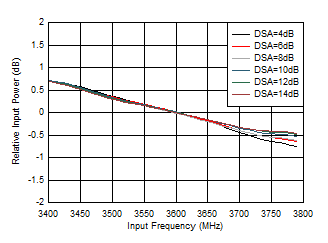
| With
3.6 GHz matching, normalized to 3.6 GHz |
|
Figure 7-137 RX
In-Band Gain Flatness, fIN = 3600 MHz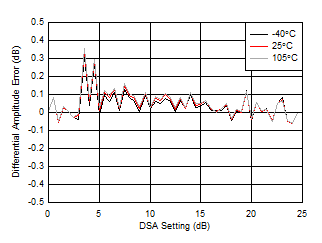
| With
3.6 GHz matching |
| Differential Amplitude Error = PIN(DSA
Setting – 1) – PIN(DSA Setting) + 1 |
Figure 7-139 RX
Uncalibrated Differential Amplitude Error vs DSA Setting at 3.6 GHz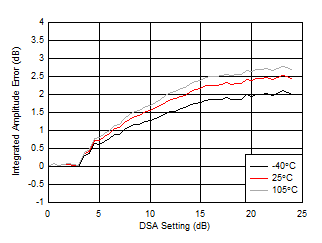
| With
3.6 GHz matching |
| Integrated Amplitude Error = PIN(DSA
Setting) – PIN(DSA Setting = 0) + (DSA
Setting) |
Figure 7-141 RX
Uncalibrated Integrated Amplitude Error vs DSA Setting at 3.6 GHz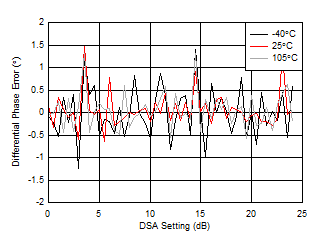
| With
3.6 GHz matching |
| Differential Phase Error = PhaseIN(DSA
Setting – 1) – PhaseIN(DSA Setting) |
Figure 7-143 RX
Uncalibrated Phase Error vs DSA Setting at 3.6 GHz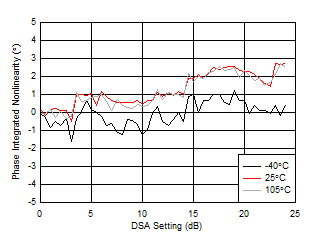
| With
3.6 GHz matching |
| Integrated Phase Error = Phase(DSA Setting) – Phase(DSA
Setting = 0) |
Figure 7-145 RX
Uncalibrated Integrated Phase Error vs DSA Setting at 3.6 GHz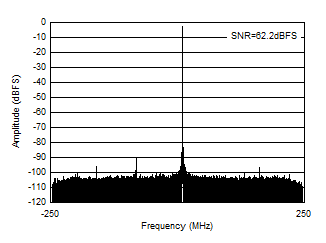
| With
3.6 GHz matching , fIN = 3610 MHz,
AIN = –3 dBFS |
|
Figure 7-147 RX
Output FFT at 3.6 GHz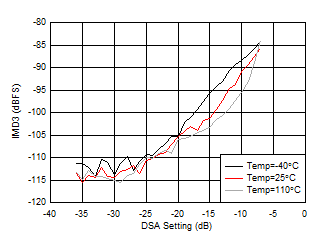
| With
3.5 GHz matching, 20-MHz tone spacing |
|
Figure 7-149 RX
IMD3 vs Input Level and Temperature at 3.6 GHz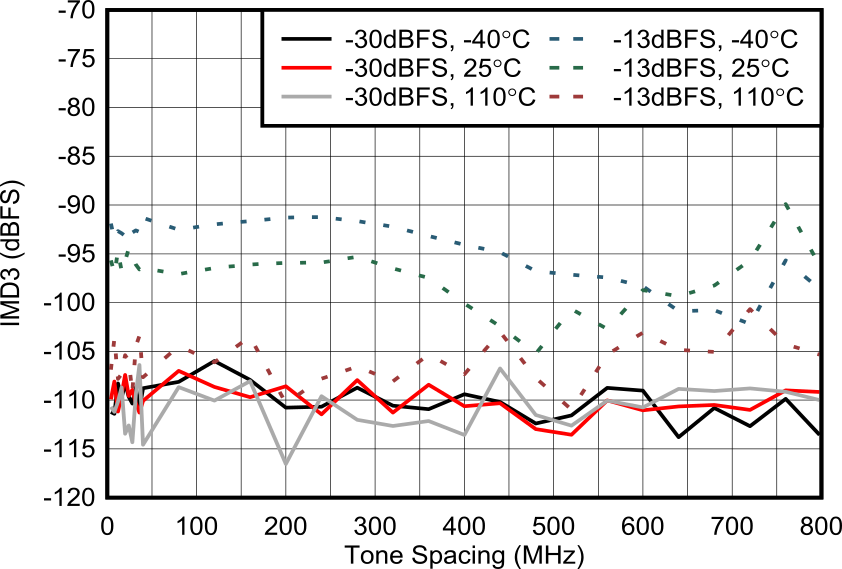
| External clock mode, 2x Decimation |
|
Figure 7-151 RX
IMD3 vs Tone Spacing at 3.76 GHz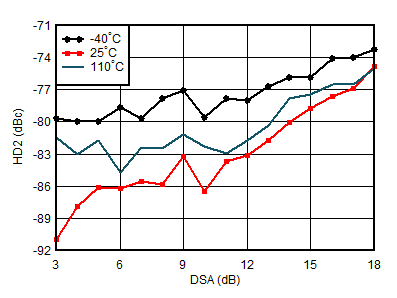
| With
3.5 GHz matching, DDC bypass mode (TI only mode for
characterization) |
Figure 7-153 RX
HD2 vs DSA Setting and Temperature at 3.6 GHz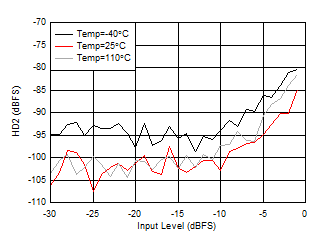
| With
3.5 GHz matching, DDC bypass mode (TI only mode for
characterization) |
Figure 7-155 RX
HD2 vs Input Level and Temperature at 3.6 GHz
| External clock mode, 25°C, 2x Decimation |
Figure 7-157 RX
HD2 vs Input Level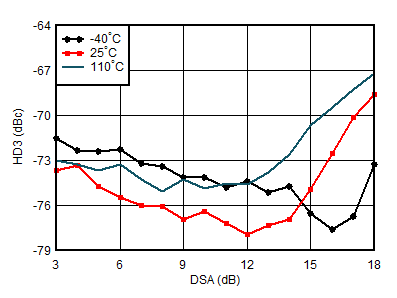
| With
3.5 GHz matching, DDC bypass mode (TI only mode for
characterization) |
Figure 7-159 RX
HD3 vs DSA Setting and Temperature at 3.6 GHz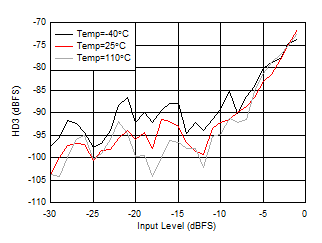
| With
3.5 GHz matching, DDC bypass mode (TI only mode for
characterization) |
Figure 7-161 RX
HD3 vs Input Level and Temperature at 3.6 GHz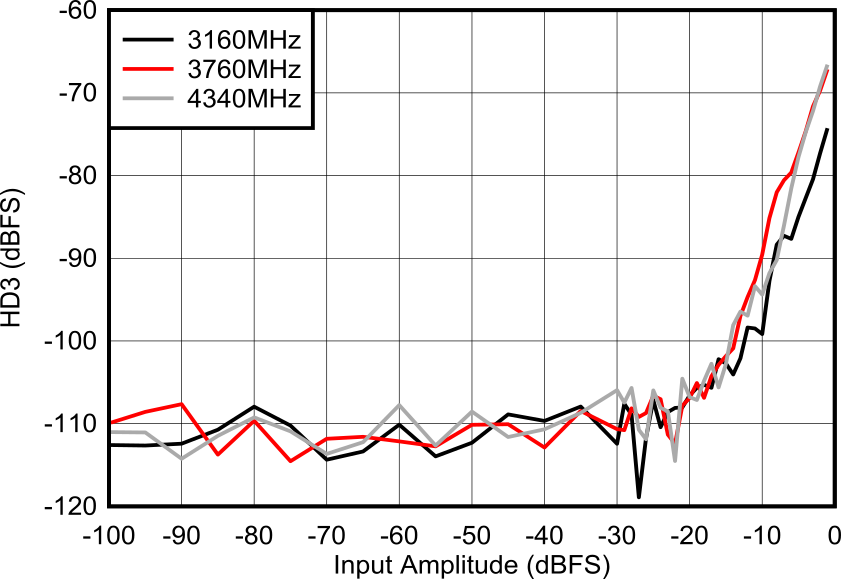
| External clock mode, 25°C, 2x Decimation |
Figure 7-163 RX
HD3 vs Input Level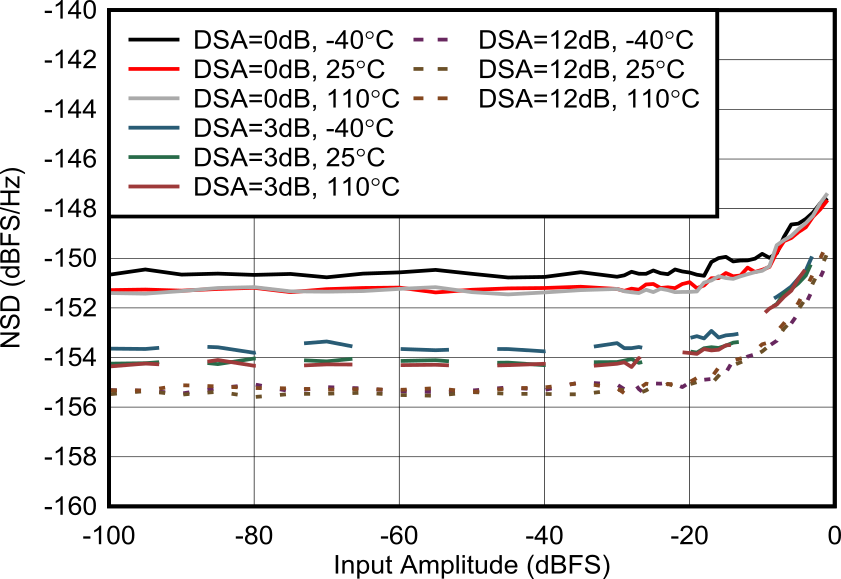
| External clock mode, 25°C, 2x Decimation |
Figure 7-165 RX
Noise Spectral Density vs Input Level at 3.76GHz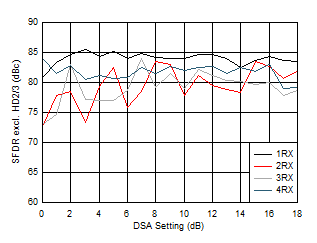 Figure 7-167 RX
SFDR Excluding HD2/3 vs DSA Setting and Channel at 3.6 GHz
Figure 7-167 RX
SFDR Excluding HD2/3 vs DSA Setting and Channel at 3.6 GHz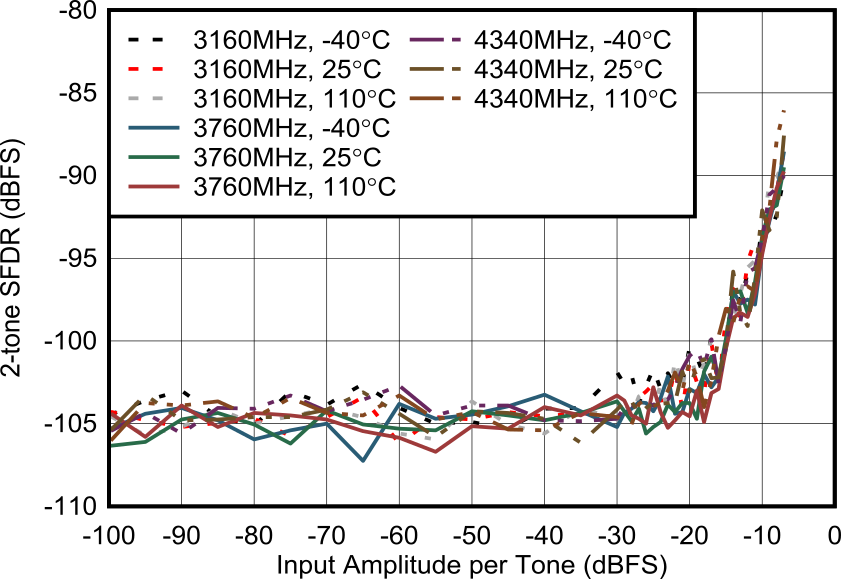
| External clock mode, 20MHz tone spacing, excluding
3rd order distortion |
Figure 7-169 RX
2-tone SFDR vs Input Amplitude and Frequency at 3.7 GHz
| With
3.6 GHz matching, –7 dBFS each tone, 20-MHz tone
spacing, all supplies at MIN, TYP, or MAX recommended
operating voltages |
Figure 7-171 RX
IMD5 vs Supply Voltage and Channel at 3.6 GHz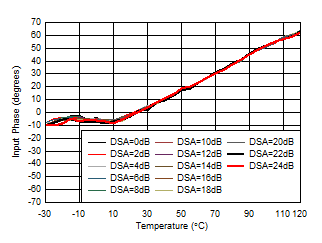
| With
3.6 GHz matching, normalized to phase at 25°C |
Figure 7-138 RX
Input Phase vs Temperature at 3.6 GHz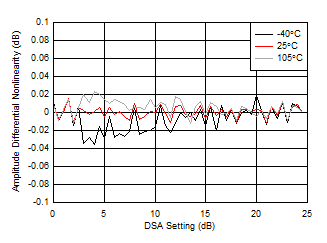
| With
3.6 GHz matching |
| Differential Amplitude Error = PIN(DSA
Setting – 1) – PIN(DSA Setting) + 1 |
Figure 7-140 RX
Calibrated Differential Amplitude Error vs DSA Setting at 3.6 GHz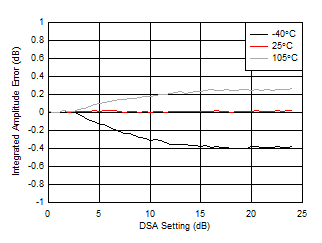
| With
3.6 GHz matching |
| Integrated Amplitude Error = PIN(DSA
Setting) – PIN(DSA Setting = 0) + (DSA
Setting) |
Figure 7-142 RX
Calibrated Integrated Amplitude Error vs DSA Setting at 3.6 GHz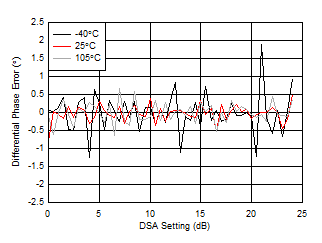
| With
3.6 GHz matching |
| Differential Phase Error = PhaseIN(DSA
Setting – 1) – PhaseIN(DSA Setting) |
Figure 7-144 RX
Calibrated Differential Phase Error vs DSA Setting at 3.6 GHz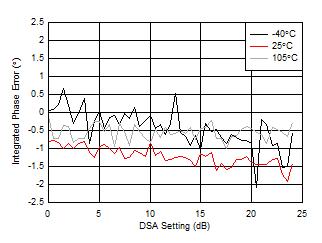
| With
3.6 GHz matching |
| Integrated Phase Error = Phase(DSA Setting) – Phase(DSA
Setting = 0) |
Figure 7-146 RX
Calibrated Integrated Phase Error vs DSA Setting at 3.6 GHz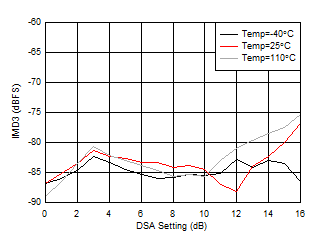
| With
3.5 GHz matching, each tone at –7 dBFS, 20-MHz tone
spacing |
Figure 7-148 RX
IMD3 vs DSA Setting and Temperature at 3.6 GHz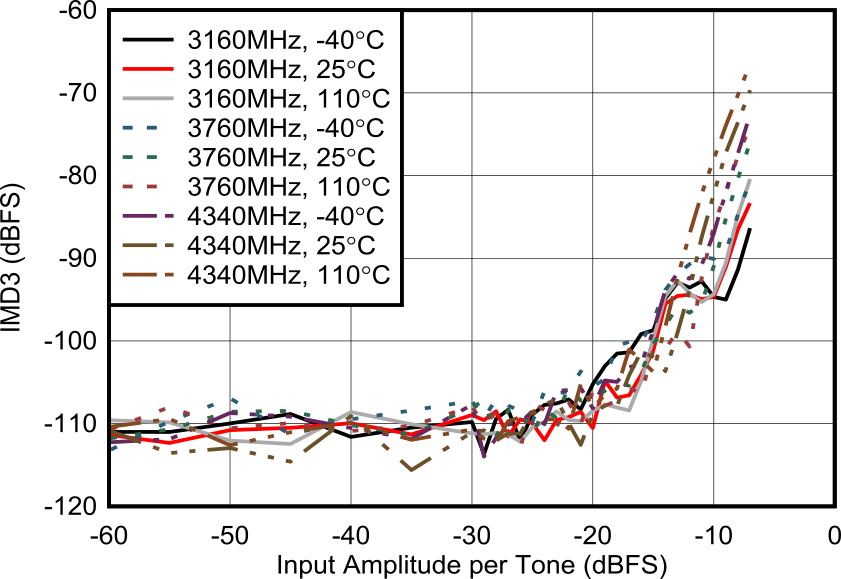
| External clock mode, 20-MHz tone spacing, 2x
Decimation |
|
Figure 7-150 RX
IMD3 vs Input Level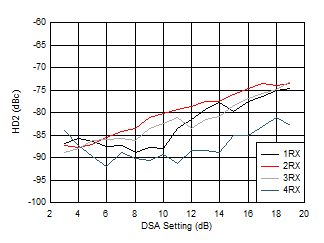
| With
3.5 GHz matching, DDC bypass mode (TI only mode for
characterization) |
Figure 7-152 RX
HD2 vs DSA Setting and Channel at 3.6 GHz
| With
3.5 GHz matching, DDC bypass mode (TI only mode for
characterization) |
Figure 7-154 RX
HD2 vs Input Level and Channel at 3.6 GHz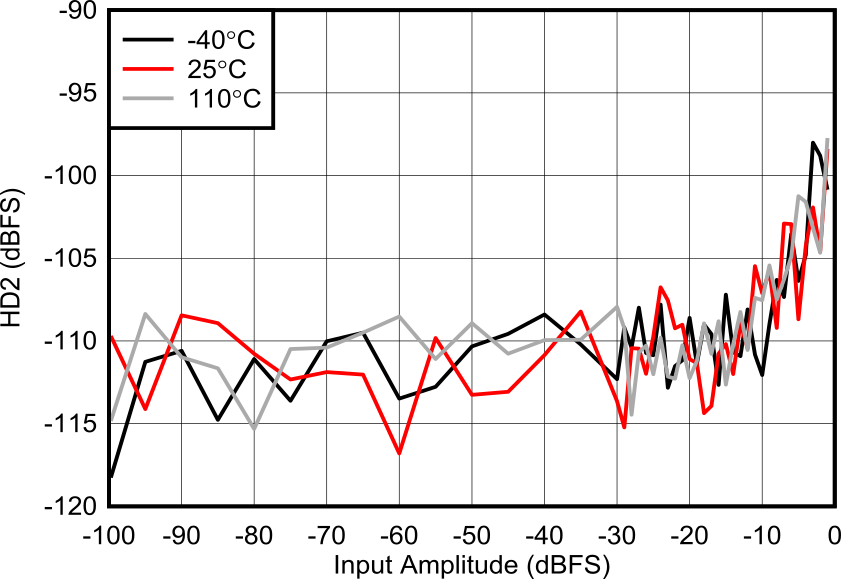
| External clock mode, 2x Decimation |
Figure 7-156 RX
HD2 vs Input Level at 3.76 GHz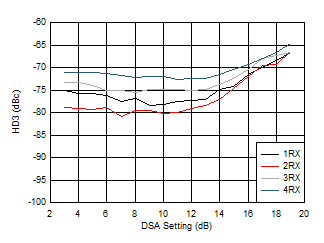
| With
3.5 GHz matching, DDC bypass mode (TI only mode for
characterization) |
Figure 7-158 RX
HD3 vs DSA Setting and Channel at 3.6 GHz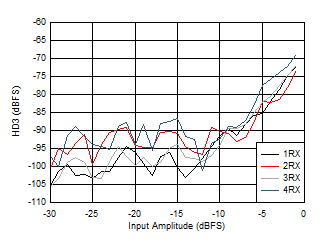
| With
3.5 GHz matching, DDC bypass mode (TI only mode for
characterization) |
Figure 7-160 RX
HD3 vs Input Level and Channel at 3.6 GHz
| External clock mode, 2x Decimation |
Figure 7-162 RX
HD3 vs Input Level at 3.76 GHz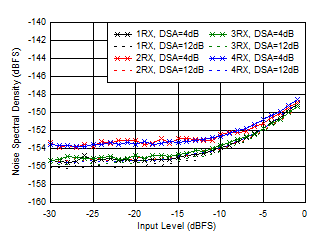
| With
3.5 GHz matching, 12.5-MHz offset from tone |
Figure 7-164 RX
Noise Spectral Density vs Input Level and DSA Setting at 3.6 GHz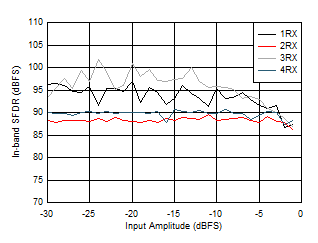 Figure 7-166 RX
In-Band SFDR (±200 MHz) vs Input Level and Channel at 3.6 GHz
Figure 7-166 RX
In-Band SFDR (±200 MHz) vs Input Level and Channel at 3.6 GHz
| External clock mode, 20MHz tone spacing, excluding
3rd order distortion |
Figure 7-168 RX
2-tone SFDR vs Input Amplitude and DSA Setting at 3.7 GHz
| With
3.6 GHz matching, –7 dBFS each tone, 20-MHz tone
spacing, all supplies at MIN, TYP, or MAX recommended
operating voltages |
Figure 7-170 RX
IMD3 vs Supply Voltage and Channel at 3.6 GHz
| With
3.6 GHz matching, tone at –20 dBFS, 12.5-MHz offset
frequency, all supplies at MIN, TYP, or MAX recommended
operating voltages |
Figure 7-172 RX
Noise Spectral Density vs Supply Voltage and Channel at 3.6 GHz


































